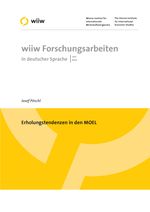Erholungstendenzen in den MOEL
Josef Pöschl
wiiw Research Report in German language No. 2010-05, June 2010
17 pages including 5 Tables and 9 Figures
(Reprint from: WIFO-Monatsberichte, Vol. 83, No. 5, May 2010)
Zusammenfassung
Die Wirtschaft dürfte sich in den mittel- und osteuropäischen Ländern (MOEL) beleben, allerdings länderweise in unterschiedlichem Ausmaß. Zwischen September 2008 und März 2009 hatte sie teilweise einen schweren Rückschlag erlitten. Polen und Albanien waren die einzigen MOEL, deren Wachstum sich nur verlangsamte, während die Wirtschaftsleistung der baltischen Länder und der Ukraine drastisch schrumpfte. Eine Rückkehr zu den kräftigen Wachstumsraten der Jahre vor 2008 ist kurz- und mittelfristig nicht sehr wahrscheinlich, da das internationale und vor allem europäische Umfeld weniger günstig ist. Zudem haben sich die Bedingungen für die Finanzierung von Investitionsprojekten nachhaltig verschlechtert. Das hohe Leistungsbilanzdefizit einzelner MOEL wird von den Handelspartnern skeptischer beurteilt, und dies beinhaltet für die baltischen Länder und die Länder Südosteuropas eine grundlegende Änderung ihrer Parameter.
English Summary
Recovery in Central and Eastern Europe
The Central and East European Countries (CEECs) have begun to show signs of more or less brisk economic recovery. It may, however, take time until their economies will have offset the severe setback they had to face between October 2008 and March 2009. The degree to which individual CEECs suffered from the international financial and economic crisis varies considerably, due to a range of different factors. Poland was an exception, as its GDP growth decelerated without coming to a complete halt in 2009. This had quite an impact as the size of the Polish GDP is similar to those of the Czech Republic, Hungary, Slovakia and Slovenia put together. The only other country where growth did not stop entirely was Albania. In sharp contrast to these two countries, the Baltic countries and Ukraine had to face a drastic decline in their GDP. The performance of all other CEECs ranged somewhere between these two extremes. It is rather unlikely that the CEECs will any time soon be returning to GDP growth rates as high as those they had achieved in the last pre-crisis years. The European and global business environment has become less propitious, and may not improve in the near future. In addition, the producing sector has been finding it more difficult and costly to get access to borrowing. Markets are likely to remain sceptic about high current account deficits, which, if true, would entail far-reaching changes in conditions especially for the Baltic and Southeast European countries.
Most of the CEECs had achieved sound fiscal results up to 2008. National budget deficits were small or even non-existent. Government debt, too, was in most cases far below the Maastricht limit. Where debt is a problem, it is mainly private debt. Inflation decelerated in the course of the crisis and has disappeared completely in several countries. There is no saying whether inflation will reaccelerate soon. What is more scaring is the rise in unemployment, which will only stop in the context of a stronger revival of GDP growth.
Keywords: transitional economies, comparative study, economic growth, fiscal and monetary policy, macroeconomic forecast, macroeconomic analysis
JEL classification: P2, O57, E17, O4
Countries covered: Albania, Bosnia and Herzegovina, Bulgaria, Croatia, Czechia, Estonia, Hungary, Kazakhstan, Latvia, Lithuania, North Macedonia, Montenegro, Poland, Romania, Russia, Serbia, Slovakia, Slovenia, Turkey, Ukraine
Research Areas: Macroeconomic Analysis and Policy, Labour, Migration and Income Distribution, International Trade, Competitiveness and FDI
